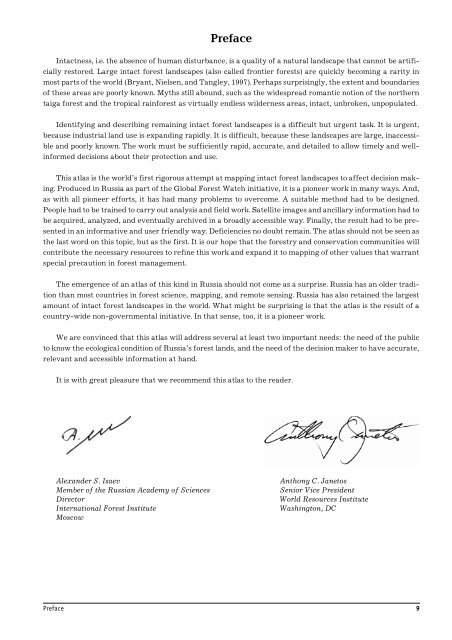Atlas of Russia's Intact Forest Landscapes - World Resources Institute
Atlas of Russia's Intact Forest Landscapes - World Resources Institute
Atlas of Russia's Intact Forest Landscapes - World Resources Institute
You also want an ePaper? Increase the reach of your titles
YUMPU automatically turns print PDFs into web optimized ePapers that Google loves.
Preface<br />
<strong>Intact</strong>ness, i.e. the absence <strong>of</strong> human disturbance, is a quality <strong>of</strong> a natural landscape that cannot be artificially<br />
restored. Large intact forest landscapes (also called frontier forests) are quickly becoming a rarity in<br />
most parts <strong>of</strong> the world (Bryant, Nielsen, and Tangley, 1997). Perhaps surprisingly, the extent and boundaries<br />
<strong>of</strong> these areas are poorly known. Myths still abound, such as the widespread romantic notion <strong>of</strong> the northern<br />
taiga forest and the tropical rainforest as virtually endless wilderness areas, intact, unbroken, unpopulated.<br />
Identifying and describing remaining intact forest landscapes is a difficult but urgent task. It is urgent,<br />
because industrial land use is expanding rapidly. It is difficult, because these landscapes are large, inaccessible<br />
and poorly known. The work must be sufficiently rapid, accurate, and detailed to allow timely and wellinformed<br />
decisions about their protection and use.<br />
This atlas is the world’s first rigorous attempt at mapping intact forest landscapes to affect decision making.<br />
Produced in Russia as part <strong>of</strong> the Global <strong>Forest</strong> Watch initiative, it is a pioneer work in many ways. And,<br />
as with all pioneer efforts, it has had many problems to overcome. A suitable method had to be designed.<br />
People had to be trained to carry out analysis and field work. Satellite images and ancillary information had to<br />
be acquired, analyzed, and eventually archived in a broadly accessible way. Finally, the result had to be presented<br />
in an informative and user friendly way. Deficiencies no doubt remain. The atlas should not be seen as<br />
the last word on this topic, but as the first. It is our hope that the forestry and conservation communities will<br />
contribute the necessary resources to refine this work and expand it to mapping <strong>of</strong> other values that warrant<br />
special precaution in forest management.<br />
The emergence <strong>of</strong> an atlas <strong>of</strong> this kind in Russia should not come as a surprise. Russia has an older tradition<br />
than most countries in forest science, mapping, and remote sensing. Russia has also retained the largest<br />
amount <strong>of</strong> intact forest landscapes in the world. What might be surprising is that the atlas is the result <strong>of</strong> a<br />
country-wide non-governmental initiative. In that sense, too, it is a pioneer work.<br />
We are convinced that this atlas will address several at least two important needs: the need <strong>of</strong> the public<br />
to know the ecological condition <strong>of</strong> Russia’s forest lands, and the need <strong>of</strong> the decision maker to have accurate,<br />
relevant and accessible information at hand.<br />
It is with great pleasure that we recommend this atlas to the reader.<br />
Alexander S. Isaev<br />
Member <strong>of</strong> the Russian Academy <strong>of</strong> Sciences<br />
Director<br />
International <strong>Forest</strong> <strong>Institute</strong><br />
Moscow<br />
Anthony C. Janetos<br />
Senior Vice President<br />
<strong>World</strong> <strong>Resources</strong> <strong>Institute</strong><br />
Washington, DC<br />
Preface<br />
9

















